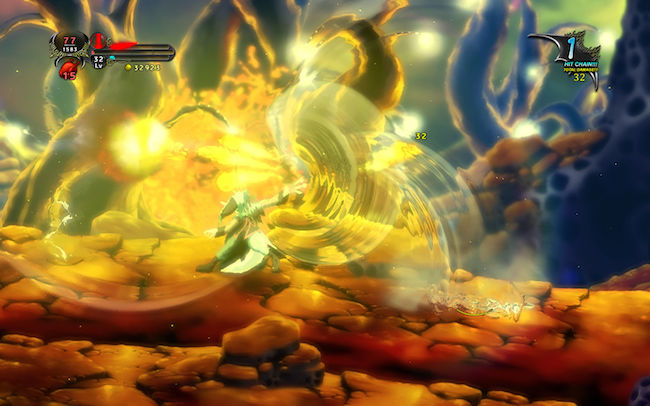
2012 was a truly great year for gaming. However, with so many stellar titles being released the year through such as Mass Effect 3, Halo 4, and Far Cry 3, it’s fair to say a number of games probably flew under the radar. Dust: An Elysian Tail is arguably one of these games, simply because it released amongst the chaos of 2012’s third quarter. Developed by a single independent designer, Dean Dodrill, over the course of three and a half years, it released to glowing reviews, and over the years has seen numerous re-releases on different platforms. With Metroidvania style games on the rise again, Dust has its work cut out for it in 2017. I had high expectations going in, and I’m pleased to say that Dust still holds up today. I’d even say it’s up there with some of the better modern Metroidvania experiences.
After some initially confusing backstory, our protagonist, Dust, wakes up in a forest with no recollection of previous events, only to be greeted by a flying, talking sword called the Blade of Ahrah, and its guardian Fidget. Seemingly connected by fate, the three set off in the search for answers to find out who Dust really is and what happened to him. While Dust: An Elysian Tail might seem like a deceptively child-like and upbeat game due to most of its characters being based off animals, the narrative gets surprisingly dark sometimes, exploring themes which create some truly emotional moments as you piece together who Dust is. It’s just a shame that some of the voice work is very hit and miss, as this results in some immersion-breaking cutscenes while fleshing out story beats.

When it’s all said and done, Dust manages to hook you in with its mystery and entices you to keep chasing the truth through its various characters and entertaining, yet generic bad guys. It all culminates very nicely, with a genuinely satisfying conclusion that’s bound to leave a smile on your face after the story revelations and twists that come before it.
Dust: An Elysian Tail is a Metroidvania title through and through, and it does what it sets out to do very well. As you explore the beautifully designed environments, you’ll regularly find roadblocks that will inevitably pique your curiosity. As expected, you can come back to these points later on once you’ve acquired new abilities such as double jumping, sliding, and wall jumping which you’ll unlock as you progress through the main story. You can move between levels as you please, all of which have items, secrets and blueprints that can be found to further improve Dust. While the platforming is relatively simple, it never fails to be entertaining, and during the last chapter of the game, there are a few sections that will test your timing, jumping and climbing skills.
What you’ll be doing more often than not is racking up ridiculously large combos and body counts with Dust’s sword – yeah, the talking one I mentioned earlier. Enemies fill the screens of each area in Dust, and you have numerous tools at your disposal as you dispatch them with finesse, speed, and incredible amounts of style. If there’s one thing Dust: An Elysian Tail absolutely nails, it’s how slick, smooth, and fast-paced its combat is. It’s hard not to feel like a superhuman as you effortlessly dance through a large group of enemies like an agile tornado of death, tossing them into the air only to grab them and bring them back down to the ground, slamming them against their helpless allies. It’s great stuff, but it also, unfortunately, brings Dust’s biggest problem to light, and it’s that the combat is actually fairly superficial. Aside from the three or four different combos you can perform with Ahrah, you have access to Fidget’s magic abilities too. While it’s initially really flashy and engaging, it quickly devolves into a shallow affair once you become more familiar with it.

I was heavily reminded of Castlevania: Symphony of the Night through Dust’s RPG elements, which are simple but effective. Dust gains experience points and levels as you decimate anything in your path and complete quests, and you can attribute skill points to improve various stats such as damage, defence, magic, and so on. On top of this, armour, rings, and weapon modifiers can be found by exploring, and they can even be crafted, utilising materials, blueprints, and the help of your local furry blacksmith. It provides a strong sense of growth to Dust aside from the new abilities you learn as you progress.
There’s also a wide array of enemies you’ll face, but none of them proves to be too difficult. A few of them might require you to parry an attack before you go in for the kill, but I never found that Dust overly challenged me on the base difficulty. It does get more interesting towards the end of the game, with wizard-looking summoners that spawn endless amounts of undead to do their murderous bidding for them, and the odd landmine-like flying ball thing never goes awry in Metroidvania games nowadays too. While Dust’s enemies might provide some entertaining brawls, the same can’t be said for the underwhelming bosses. They pose little more, and sometimes even less challenge than some of the regular enemies, and more often than not they just act as glorified damage sponges, making for mind-numbing, monotonous encounters.
If there’s one thing that Dust: An Elysian Tail consistently gets right, it’s that it always looks absolutely stunning, performs impeccably, and all this is accompanied by a truly magical musical score. Originally envisioned as 8-bit sprites, all of Dust’s environments and characters ended up being beautifully hand drawn. It’s colourful, expertly animated, and still stands today as an example of what 2D games can achieve in terms of visual fidelity. The musical score, which is all composed by HyperDuck SoundWorks, consistently outdoes itself, with each track being carefully crafted to make sure it fits its environment.

Dust: An Elysian Tail stands as a shining example of what indie developers can achieve with a bit of support behind them. After three and a half years of hard work, Dean Dodrill created a great game – one that, while not flawless, is criminally underrated and is definitely worth your time. With a strong story to boot, a well-rounded cast of characters, and slick combat, all wonderfully complimented by a beautiful hand drawn art style and a world that’s just as engrossing as the mystery it presents, Dust offers a lot of content for its asking price. The main story clocks in at about nine hours, plus there is heaps of side content to tackle too. It does occasionally stumble with its boss fights, voice acting and combat system, but there’s no doubt this is a Metroidvania title to remember for years to come.











